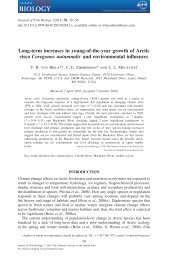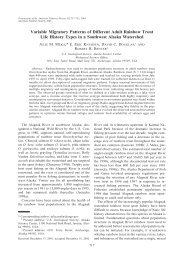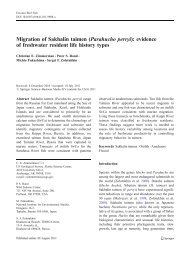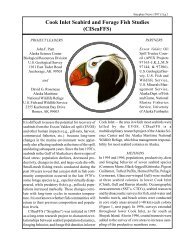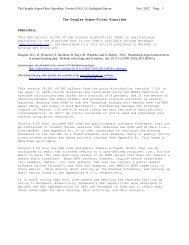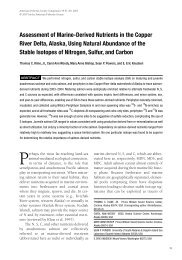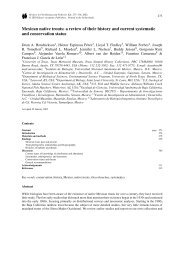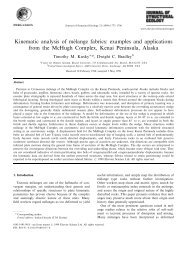Mondragon, J., S. J. Taggart, A. G. Andrews, J. K. Nielsen, and J. de ...
Mondragon, J., S. J. Taggart, A. G. Andrews, J. K. Nielsen, and J. de ...
Mondragon, J., S. J. Taggart, A. G. Andrews, J. K. Nielsen, and J. de ...
- No tags were found...
Create successful ePaper yourself
Turn your PDF publications into a flip-book with our unique Google optimized e-Paper software.
Proceedings of the Fourth Glacier BayScience SymposiumOctober 26-28, 2004Juneau, AlaskaEdited by John F. Piatt <strong>and</strong> Scott M. Gen<strong>de</strong>Sponsored by: U.S. Geological Survey Alaska Science Center, National ParkService Alaska Regional Office, <strong>and</strong> Glacier Bay National Park <strong>and</strong> PreserveScientific Investigations Report 2007-5047U.S. Department of the InteriorU.S. Geological Survey
U.S. Department of the InteriorDIRK KEMPTHORNE, SecretaryU.S. Geological SurveyMark D. Myers, DirectorU.S. Geological Survey, Reston, Virginia: 2007For product <strong>and</strong> or<strong>de</strong>ring information:World Wi<strong>de</strong> Web: http://www.usgs.gov/pubprodTelephone: 1-888-ASK-USGSFor more information on the USGS--the Fe<strong>de</strong>ral source for science about the Earth, its natural <strong>and</strong> living resources,natural hazards, <strong>and</strong> the environment:World Wi<strong>de</strong> Web: http://www.usgs.govTelephone: 1-888-ASK-USGSAny use of tra<strong>de</strong>, product, or firm names is for <strong>de</strong>scriptive purposes only <strong>and</strong> does not imply endorsement by theU.S. Government.Although this report is in the public domain, permission must be secured from the individual copyright owners toreproduce any copyrighted materials contained within this report.Suggested citation:Piatt, J.F., <strong>and</strong> Gen<strong>de</strong>, S.M., eds., 2007, Proceedings of the Fourth Glacier Bay Science Symposium: U.S. GeologicalSurvey Scientific Investigations Report 2007-5047, 246 p.
84 Proceedings of the Fourth Glacier Bay Science SymposiumSpatial Distribution <strong>and</strong> Abundance of Tanner <strong>and</strong> Red King Crab Insi<strong>de</strong> <strong>and</strong>Outsi<strong>de</strong> of Marine Reserves in Glacier Bay, AlaskaJennifer <strong>Mondragon</strong> 1,3 , Spencer J. <strong>Taggart</strong> 1 , Alex<strong>and</strong>er G. <strong>Andrews</strong> 1 , Julie K. <strong>Nielsen</strong> 1 <strong>and</strong> Jim <strong>de</strong> La Bruere 2Abstract. Closure of commercial fishing for Tanner crab (Chionoecetes bairdi) <strong>and</strong> red king crab (Paralitho<strong>de</strong>s camtschaticus)in parts of Glacier Bay National Park created a network of five protected areas. The purpose of this study was to <strong>de</strong>termine therelative abundance <strong>and</strong> spatial distribution of king <strong>and</strong> Tanner crab insi<strong>de</strong> <strong>and</strong> outsi<strong>de</strong> of the marine reserve network. Using crabpots, we systematically sampled Glacier Bay <strong>and</strong> estimated the <strong>de</strong>nsity <strong>and</strong> relative abundance of crabs. Our data <strong>de</strong>monstratethat reserves in close proximity to each other have very different crab abundances; the majority of the Tanner crab were in tworeserves, <strong>and</strong> most (73 percent) of the king crab were in a small part of a single reserve. This study <strong>de</strong>monstrates the value ofsystematic sampling for marine reserve <strong>de</strong>sign <strong>and</strong> location.IntroductionIn 1999, the U.S. Congressclosed fishing in parts of Glacier BayNational Park, creating one of NorthAmerica’s largest marine reserves.Throughout the world marineprotected areas are promoted aseffective tools for managing fisherieswhile simultaneously meeting marineconservation goals <strong>and</strong> maintainingmarine biodiversity (Agardy, 1997).To evaluate marine reserve efficacy<strong>and</strong> measure population changes inresponse to protection, it is essentialto un<strong>de</strong>rst<strong>and</strong> the abundance, age(or size) structure, <strong>and</strong> spatialdistribution of populations insi<strong>de</strong><strong>and</strong> outsi<strong>de</strong> the reserves (NationalResearch Council, 1999).Figure 1. Catch per unit effort (CPUE) of Tanner crab <strong>and</strong> red king crab during a systematicsurvey of Glacier Bay. Commercial fishing is closed in five areas of the Bay <strong>and</strong> remainsopen in the central Bay.The fisheries closures in Glacier Bay provi<strong>de</strong> animportant opportunity to study marine reserve <strong>de</strong>sign <strong>and</strong>effectiveness for high latitu<strong>de</strong> species such as king <strong>and</strong> Tannercrabs. The legislation closed commercial fishing for Tannercrab (Chionoecetes bairdi) in five areas (fig. 1) in GlacierBay, forming a network of closures. The central part of theBay remains open to Tanner crab fishing, but is scheduledfor closure upon the retirement of current commercial permithol<strong>de</strong>rs (Department of the Interior, 1999). For red king crab(Paralitho<strong>de</strong>s camtschaticus), all of Glacier Bay proper wasclosed to commercial fishing in 1999.The purpose of this study was to <strong>de</strong>termine the relativeabundance <strong>and</strong> distribution of king <strong>and</strong> Tanner crab insi<strong>de</strong><strong>and</strong> outsi<strong>de</strong> the marine reserve network in Glacier Bay.Information from this survey will be used to (1) <strong>de</strong>scribethe distribution of Tanner <strong>and</strong> red king crabs in a large fjor<strong>de</strong>stuarine system; (2) predict the effectiveness of the reservesin Glacier Bay; <strong>and</strong> (3) provi<strong>de</strong> baseline data to measure theeffectiveness of marine reserves over time.1U.S. Geological Survey, Alaska Science Center, 1300 National Park Road,Juneau AK 998012U.S. Geological Survey, Alaska Science Center, P.O. Box 140,Gustavus, AK 998263Current address for corresponding author: NMFS, Alaska Region, 709 W.9 th Street, Juneau, AK 99802 jennifer.mondragon@noaa.gov, 907-586-8743
Jennifer <strong>Mondragon</strong> <strong>and</strong> others 85MethodsIn July <strong>and</strong> August 2002, the relative abundance ofTanner <strong>and</strong> red king crabs was estimated by systematicallysampling 415 stations throughout Glacier Bay. Crabs werecollected using conical, top-loading, commercial Tanner crabpots. To target juvenile <strong>and</strong> female crabs, a commercial shrimppot was attached to each of the conical Tanner crab pots witha 20 m tether. A U.S. Geological Survey research vessel, theUSGS R/V Alaskan Gyre, was used to <strong>de</strong>ploy <strong>and</strong> retrieve crabpots. Sixteen pots were set each afternoon <strong>and</strong> pulled the nextmorning after a soak time of 15 to 20 hours. As the pots wereretrieved, we counted <strong>and</strong> i<strong>de</strong>ntified all organisms to species.Carapace sizes, width for Tanner crabs, <strong>and</strong> length for kingcrabs, were measured to the nearest millimeter with verniercalipers.Results <strong>and</strong> DiscussionTanner crabs were wi<strong>de</strong>ly distributed throughout GlacierBay, <strong>and</strong> 69 percent of the pots captured at least one crab. Theonly area where crabs were consistently not captured was themain channel of the lower Bay, between Willoughby Isl<strong>and</strong><strong>and</strong> the mouth of the Bay (fig. 1). The absence of Tannercrabs in this area suggests poor habitat for this species. Theexistence of a habitat barrier could restrict movement ofTanner crabs between Glacier Bay <strong>and</strong> Icy Strait. If this is thecase, the Tanner crab population in the Bay may be <strong>de</strong>pen<strong>de</strong>nton larval flux for connectivity between the larger crabmetapopulations in southeastern Alaska.Densities of Tanner crabs were not significantly differentbetween the reserve network <strong>and</strong> the area open to commercialfishing in the central Bay (fig. 2). However, <strong>de</strong>nsities ofadults <strong>and</strong> juvenile Tanner crabs varied among reserves; theaverage catch of adults was higher in the East Arm, GeikieInlet, Scidmore-Charpentier Inlet, <strong>and</strong> the central Bay thanthe other two reserves (fig. 2). The higher <strong>de</strong>nsity of juvenilecrabs in the reserves was due to their high concentrations inWachusett Inlet <strong>and</strong> the distal ends of Scidmore-CharpentierInlet, both narrow glacial fjords (fig. 1). These areas possiblyrepresent nursery areas for Tanner crabs. If so, their inclusionin the marine reserves is particularly important for long-termeffectiveness.In contrast to the wi<strong>de</strong>spread distribution of Tanner crabs,red king crabs were highly aggregated; 73 percent of the kingcrabs were captured in seven adjacent stations near the mouthof the East Arm reserve (fig. 1). These data indicate that<strong>de</strong>sign of an effective marine reserve for red king crab willrequire <strong>de</strong>tailed sampling to <strong>de</strong>lineate patches of high <strong>de</strong>nsity.Conclusions <strong>and</strong> Management ImplicationsOur data show that reserves in close proximity havevery different abundances of king <strong>and</strong> Tanner crabs; not allreserves are created equal. This study <strong>de</strong>monstrates the valueof systematic sampling for marine reserve <strong>de</strong>sign <strong>and</strong> location.The ongoing marine reserve research in Glacier Bay willprovi<strong>de</strong> valuable information to managers, scientists, <strong>and</strong> thepublic to evaluate the utility of reserves as a management toolfor solving local, national, <strong>and</strong> global marine conservationissues.Average CPUEAdult Tanner CrabAverage CPUEJuv. Tanner Crab2015105086420p=0.065p
86 Proceedings of the Fourth Glacier Bay Science SymposiumAcknowledgmentsThanks to G. Bishop, J. Douglas, J. Clark, G. Eckert, L.Eisner, L. Etherington, C. Hoover, Z. Hoyt, J. Mitchell, <strong>and</strong> S.Tamone for their valuable assistance. Funding for this projectwas provi<strong>de</strong>d by Glacier Bay National Park <strong>and</strong> Preserve <strong>and</strong>the U.S. Geological Survey, Alaska Science Center.References CitedAgardy, T.S., 1997, Marine protected areas <strong>and</strong> oceanconservation: Aca<strong>de</strong>mic Press, R.G. L<strong>and</strong>es Company,244 p..Department of the Interior, 1999, Glacier Bay National Park,AK: Commercial Fishing Regulations, Final Rule. 36 CFRPart 13, v. 64, p. 56,455–56,464.National Research Council, 1999, Sustaining marine fisheries:Washington, D.C., National Aca<strong>de</strong>my Press, 164 p.Suggested Citation<strong>Mondragon</strong>, J., <strong>Taggart</strong>, S.J., <strong>Andrews</strong>, A.G., <strong>Nielsen</strong>, J.K.,<strong>de</strong> La Bruere, J., 2007, Spatial distribution <strong>and</strong> relativeabundance of Tanner <strong>and</strong> red king crab insi<strong>de</strong> <strong>and</strong> outsi<strong>de</strong>of marine reserves in Glacier Bay, Alaska, in Piatt, J.F., <strong>and</strong>Gen<strong>de</strong>, S.M., eds., Proceedings of the Fourth Glacier BayScience Symposium, October 26–28, 2004:U.S. Geological Survey Scientific Investigations Report2007-5047, p. 84-86.U-shaped glacial valley at the head of Dundas Bay. (Photograph by Bill Eichenlaub, National Park Service.)





